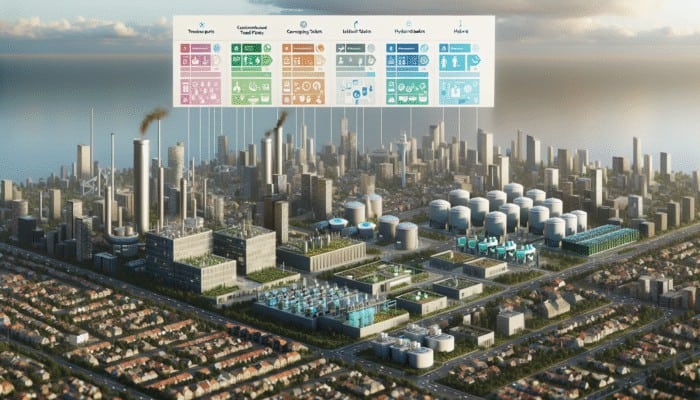Understanding the Crucial Role of Sanitation in Urban Settings
City Sanitation Solutions: The significance of effective sanitation in urban landscapes cannot be overstated; it serves as the foundation for thriving, healthy cities. Sanitation influences not only public health outcomes but also plays a critical role in maintaining environmental integrity and bolstering economic stability. Urban areas, characterised by high population density and substantial waste production, encounter distinct challenges that demand robust and sustainable city sanitation solutions. By examining the multifaceted benefits of sanitation, we can better understand its crucial role in urban planning and development.
Enhancing Public Health through Effective Sanitation Practices

At the heart of successful city sanitation solutions lies their profound influence on public health. In densely populated urban environments, where the swift transmission of communicable diseases can have devastating effects, efficient sanitation systems are vital for disease prevention. For example, regions with inadequate sanitation services frequently experience outbreaks of diseases such as cholera, dysentery, and typhoid fever. The World Health Organization (WHO) emphasizes that improved sanitation can lead to substantial reductions in these illnesses, thereby significantly improving overall health outcomes for urban populations.
Moreover, access to clean and safe sanitation facilities diminishes exposure to harmful pathogens, directly resulting in reduced morbidity and mortality rates. Vulnerable groups such as children, older people, and individuals with weakened immune systems are especially at risk, underscoring the necessity for urban planners to prioritise sanitation infrastructure that protects these sensitive demographics. By investing in effective sanitation, cities can not only address immediate public health threats but also enhance the quality of life for their residents, fostering healthier and more resilient communities.
Assessing the Environmental Consequences of Inadequate Sanitation
The environmental repercussions of poor sanitation are severe, often resulting in the pollution of waterways, degradation of soil quality, and loss of biodiversity. Urban areas generate substantial amounts of waste, and without effective management, this refuse can contaminate natural resources, thereby adversely affecting both ecosystems and human health. Sustainable city sanitation solutions are crucial in mitigating these risks by incorporating waste treatment processes that safeguard the environment.
For instance, a city that implements a comprehensive waste management strategy can drastically reduce the amount of waste that is transported to landfills, which in turn diminishes greenhouse gas emissions. Establishing systems that treat wastewater for reuse demonstrates how urban areas can conserve precious water resources, a growing concern in today's climate-challenged world. By prioritising environmentally responsible practices within sanitation management, cities can protect natural ecosystems and guarantee the sustainability of their urban environments for future generations.
Unlocking Economic Opportunities Through Sanitation Investments
Investing in sanitation unlocks substantial economic advantages, which are often overlooked in favour of addressing more immediate concerns. Poor sanitation can lead to soaring healthcare costs due to the need for disease management, lost productivity stemming from illness, and a general decline in quality of life that inhibits economic development. Research indicates that for every dollar spent on sanitation, cities can expect a return of approximately $5 in economic benefits, primarily through decreased healthcare costs and improved worker productivity.
Cities that prioritize city sanitation solutions also become magnets for investment and tourism, as clean, well-managed urban areas are more attractive to businesses and visitors alike. This cycle of economic advantages creates a positive feedback loop wherein improved sanitation fosters economic growth, which in turn drives further investment in sanitation and urban infrastructure. As cities across the globe contend with rapid urbanisation, recognising sanitation as a fundamental economic driver is essential for sustainable development.
Exploring Diverse Sanitation Systems

Gaining insight into the various sanitation systems available is crucial for implementing effective city sanitation solutions. Each system presents its advantages and challenges, and the choice often depends on factors such as urban population density, available resources, and specific local conditions. By categorising sanitation systems into centralized, decentralized, and hybrid models, urban planners can tailor solutions to meet the unique needs of their communities.
Centralised Sanitation Systems: Efficiency in Densely Populated Areas
Centralised sanitation systems are designed to collect and treat waste at a singular location, making them particularly suitable for densely populated urban areas. These systems typically consist of extensive networks of sewer pipes that transport wastewater to treatment plants, where it undergoes rigorous processing before being safely discharged or reused. The efficiency of centralised systems allows for high treatment outputs, which is especially critical in cities with substantial waste generation and population density.
However, centralised systems are not without their obstacles. They necessitate considerable upfront capital investment and continuous maintenance, which can strain municipal budgets. Additionally, cities that are susceptible to flooding or natural disasters may find centralised systems vulnerable, as overflows can result in environmental contamination. Despite these challenges, advances in technology and treatment methodologies continue to improve the effectiveness of centralized systems, rendering them a viable option for many urban centers.
Decentralised Sanitation Systems: Tailored Solutions for Diverse Needs
Decentralized sanitation systems offer an alternative approach, particularly advantageous for less-dense urban environments or areas lacking comprehensive infrastructure. These systems often feature smaller, localised treatment facilities that manage waste closer to its source. By employing innovative technologies such as composting toilets, biogas systems, and constructed wetlands, decentralised systems can efficiently handle waste while minimising environmental impact.
One of the primary benefits of decentralised systems is their adaptability; they can be customised to meet the specific needs and capacities of distinct communities. For example, rural or peri-urban areas that lack the financial resources to support centralised infrastructure can benefit from smaller-scale solutions that are often more economical and easier to maintain. By investing in decentralised sanitation solutions, cities can enhance service delivery and ensure that even the most underserved communities have access to essential sanitation services.
Hybrid Sanitation Systems: Combining Approaches for Optimal Outcomes

As urban landscapes become increasingly diverse, hybrid sanitation systems that integrate features of both centralised and decentralised approaches are gaining popularity. These systems provide flexibility by allowing cities to optimise sanitation management based on local conditions, population density, and environmental considerations. For instance, a city might employ centralized systems for its urban core while utilizing decentralized facilities in peripheral areas.
Hybrid systems harness the strengths of both models, enabling cities to maximize efficiency while minimizing risks associated with reliance on a single type of sanitation solution. By incorporating advanced technologies such as real-time monitoring and feedback mechanisms, hybrid systems can enhance operational efficiency and responsiveness. As urban planners seek sustainable solutions that cater to an array of needs and challenges, hybrid systems emerge as a promising path forward for effective city sanitation solutions.
Strategic Waste Management Approaches
Effective waste management is a cornerstone of successful sanitation systems, playing a pivotal role in the overall health of urban environments. Through strategic planning and innovative methodologies, cities can ensure that waste is managed responsibly, thus minimising its impact on public health and the environment. Waste management strategies encompass a variety of practices, including waste segregation, treatment, disposal, and reduction, each contributing to the efficacy of city sanitation solutions.
Implementing Waste Segregation for Improved Recycling
Waste segregation serves as the foundational step in effective waste management, empowering cities to enhance recycling and composting efforts while alleviating landfill burdens. By separating waste at the source—typically into categories such as organic, recyclable, and hazardous materials—urban populations can significantly improve the efficiency of waste processing systems. Cities like Tokyo, Japan, and Oslo, Norway, stand as exemplary models of successful waste segregation programs that promote environmental sustainability and community engagement.
Education plays a vital role in the success of waste segregation initiatives. Communities must comprehend the importance of separating their waste and the beneficial impacts this can have on both the environment and public health. Campaigns that raise awareness and provide clear guidelines can empower residents to engage in waste segregation efforts actively. Furthermore, implementing convenient systems, such as designated collection bins and regular pickup schedules, encourages compliance and boosts participation rates.
Additionally, cities can collaborate with local businesses and organisations to reinforce waste segregation practices. Partnering with schools, community centres, and corporations can cultivate a culture of environmental responsibility, underscoring the significance of individual actions in broader sustainability goals. By embedding waste segregation into the urban fabric, cities can establish a solid foundation for advancing comprehensive waste management strategies.
Innovative Waste Treatment Techniques for Resource Recovery
Effective waste treatment methodologies are crucial for converting waste into valuable resources or energy, thereby minimizing environmental harm. Various treatment techniques, including composting, anaerobic digestion, and incineration, can transform waste into usable products while significantly reducing landfill contributions. Cities that implement such systems experience numerous benefits, including reduced waste volume and the generation of energy from previously discarded materials.
For instance, composting organic waste not only diverts it from landfills but also produces nutrient-rich compost that can be utilised to enrich soil in urban gardens and farms. This creates a closed-loop system that enhances local food production while promoting sustainable practices. Similarly, anaerobic digestion can convert organic waste into biogas, a renewable energy source that can power homes and businesses. Cities like San Francisco have embraced these technologies, achieving ambitious waste diversion goals while fostering a culture of sustainability.
Incineration, when conducted with advanced pollution control technologies, can also be an effective waste treatment method that significantly reduces the volume of waste. Cities that adopt this approach can generate energy from waste, contributing to local power grids while minimising landfill dependence. However, it is essential to ensure that incineration facilities adhere to stringent environmental regulations to prevent air pollution and other detrimental effects on public health.
Safe Waste Disposal Practices to Protect Public Health
Proper waste disposal methods are critical for ensuring that waste does not pose risks to the environment or public health. While landfills are a common method of disposal, they present significant challenges, including the potential for groundwater contamination and the release of greenhouse gases. Consequently, cities are increasingly exploring alternative waste disposal strategies that prioritise environmental safety and sustainability.
One effective method is the implementation of sanitary landfills, designed with advanced lining systems and leachate collection mechanisms to minimise environmental impact. However, even with sanitary landfills, cities must prioritise reducing the volume of waste sent to these sites by investing in recycling and composting initiatives. This approach not only conserves space but also mitigates the environmental consequences associated with waste disposal.
Additionally, innovative disposal methods, such as waste-to-energy plants, convert waste into electricity through combustion or anaerobic processes. These systems offer dual benefits by reducing waste volume and generating renewable energy. Cities with robust waste-to-energy programs, such as Copenhagen, Denmark, exemplify how effective waste disposal can contribute to sustainable urban development.
Ultimately, a multifaceted approach to waste disposal, combining various strategies, will yield the most effective results. By prioritising waste reduction, recycling, and innovative disposal methods, cities can establish a sustainable waste management system that protects both public health and the environment.
Promoting Waste Reduction to Tackle Urban Waste Challenges
The concept of waste reduction is vital in addressing the growing challenges associated with urban waste management. By minimising the total volume of waste generated, cities can alleviate pressure on sanitation systems and promote sustainable practices. Effective waste reduction strategies encompass various initiatives, including minimising packaging, encouraging the use of reusable products, and fostering a culture of sustainability within communities.
One of the most impactful approaches to waste reduction involves collaborating with manufacturers and retailers to minimise packaging. Initiatives that encourage businesses to adopt eco-friendly packaging solutions can significantly decrease waste generation. For example, cities can support the implementation of policies that incentivise companies to utilise minimal or biodegradable packaging, thus reducing the environmental impact of consumer goods.
Promoting reusable products represents another critical component of waste reduction. Cities can launch campaigns advocating for the use of reusable bags, containers, and water bottles, thereby diminishing reliance on single-use items. Public awareness campaigns can illustrate the benefits of adopting reusable alternatives, motivating community members to make sustainable choices in their daily lives.
Furthermore, engaging local communities in waste reduction initiatives fosters a sense of collective responsibility. Educational programs that highlight the importance of reducing waste and its environmental impact can empower individuals to take action. By cultivating a culture of sustainability and environmental stewardship, cities can pave the way for significant reductions in overall waste generation, aligning with their broader city sanitation solutions goals.
Harnessing Technological Innovations for Sanitation
In an era defined by rapid technological advancements, the integration of innovative solutions into sanitation practices is transforming urban environments. From smart sanitation systems to sustainable materials, these technologies enhance the efficiency and effectiveness of urban sanitation solutions, contributing to healthier and cleaner urban spaces. Understanding the latest innovations in sanitation allows city planners to optimise their strategies and embrace a more sustainable future.
Revolutionising Sanitation with Smart Technologies
The rise of the Internet of Things (IoT) and artificial intelligence (AI) has ushered in a new era of smart sanitation solutions. These technologies enable real-time monitoring and management of sanitation processes, optimising efficiency and responsiveness. For instance, smart sensors can detect waste levels in bins and alert sanitation workers when collections are required, thereby reducing operational costs and enhancing service delivery.
Cities like Barcelona have implemented smart sanitation systems that utilise data analytics to optimise waste collection routes, reducing fuel consumption and minimising environmental impact. By leveraging technology, urban areas can create more efficient waste management systems that adapt to changing conditions and demands.
Moreover, smart sanitation technologies enhance public health by monitoring sanitation facilities and water quality in real-time. This proactive approach allows cities to identify potential issues before they escalate, ensuring that residents have access to safe and clean sanitation services. The integration of smart technologies into sanitation practices not only improves operational efficiency but also elevates the overall quality of urban living.
Advancing Water Recycling Practices for Sustainable Resource Management
Water scarcity is an increasingly pressing issue faced by urban areas worldwide, making water recycling a crucial component of sustainable city sanitation solutions. Advanced treatment systems can purify wastewater for reuse, conserving precious water resources and reducing environmental impact. By adopting water recycling practices, cities can mitigate the effects of drought and ensure a sustainable water supply for their residents.
For example, Singapore has embraced water recycling initiatives through its NEWater programme, which treats and purifies wastewater for non-potable applications such as irrigation and industrial processes. This innovative approach not only conserves water but also demonstrates the feasibility of integrating recycled water into urban settings.
Furthermore, cities can implement greywater recycling systems that capture water from sinks, showers, and washing machines for reuse in toilet flushing and landscape irrigation. By promoting water recycling practices, cities can cultivate a culture of conservation and sustainability, ensuring that urban populations have access to the resources they need while protecting the environment.
Utilising Biodegradable Materials for Sustainable Sanitation
The adoption of biodegradable materials in sanitation products is pivotal for reducing long-term environmental harm. Traditional plastics significantly contribute to pollution and waste accumulation, posing long-term threats to ecosystems and human health. By transitioning to biodegradable alternatives, cities can mitigate the environmental impact associated with waste generated from sanitation products.
Innovative companies are developing biodegradable materials designed to break down naturally over time, thereby alleviating the burden on landfills and minimizing pollution. Cities can promote the use of these materials in sanitation products, such as single-use hygiene items and packaging, thereby fostering a culture of environmental responsibility.
Moreover, educational campaigns that highlight the benefits of biodegradable materials can encourage residents to make informed choices about their waste. By raising awareness about the environmental impact of traditional plastics and promoting sustainable alternatives, cities can empower communities to actively participate in reducing their ecological footprints.
Enhancing Sanitation Management with Digital Twin Technology
Digital twin technology is revolutionizing urban sanitation management by creating virtual models of sanitation systems that enable real-time monitoring and predictive maintenance. This innovative approach enables cities to simulate various scenarios, optimise resource allocation, and enhance system performance. By leveraging digital twin technology, urban planners can gain valuable insights into the efficacy of their sanitation solutions and anticipate potential challenges.
For instance, cities utilising digital twin technology can monitor sewer systems for blockages or leaks, enabling proactive maintenance that prevents costly repairs and service disruptions. By employing data-driven insights, urban areas can optimise their sanitation infrastructure, ensuring that it meets the evolving needs of their communities.
Furthermore, digital twin technology can facilitate collaboration among multiple stakeholders, including government agencies, private sector partners, and community organisations. By fostering data sharing and transparency, cities can enhance decision-making processes and create more resilient sanitation systems. The integration of digital twin technology represents a significant advancement in the pursuit of effective city sanitation solutions, allowing cities to adapt to changing conditions while ensuring public health and environmental sustainability.
Fostering Community Engagement in Sanitation Initiatives
The success of city sanitation solutions relies heavily on active community engagement, ensuring that residents are informed, empowered, and involved in sanitation initiatives. By nurturing a culture of collaboration between local governments and communities, cities can enhance the effectiveness of their sanitation strategies and cultivate healthier urban environments. Community engagement encompasses education programmes, public participation, and volunteer initiatives, each contributing to a more sustainable future.
Empowering Communities through Education Programs
Educating communities about sanitation practices is essential for fostering a culture of cleanliness and responsibility. Comprehensive education programmes can empower residents with the knowledge and skills necessary to engage in sanitation initiatives and make informed decisions regarding waste management. For instance, cities can implement workshops, seminars, and outreach campaigns that emphasise the significance of sanitation and hygiene practices.
Schools represent a vital platform for implementing sanitation education, as children tend to be more receptive to learning about environmental stewardship. By integrating sanitation topics into school curricula, cities can instill habits of cleanliness and responsibility from an early age. Engaging students in hands-on activities, such as community clean-up days or recycling competitions, can reinforce these lessons while fostering a sense of ownership over their environment.
Moreover, leveraging digital platforms and social media can amplify sanitation education efforts, reaching broader audiences and engaging residents in meaningful ways. Interactive campaigns that encourage community participation and feedback can create a sense of shared responsibility, motivating individuals to take action in their neighbourhoods.
Encouraging Public Participation in Sanitation Planning
Involving the public in sanitation planning and maintenance enhances community ownership and effectiveness. Cities that actively engage residents in decision-making processes related to sanitation initiatives can ensure that solutions are tailored to local needs and perspectives, thereby enhancing the effectiveness of these initiatives. Public participation can take many forms, including community forums, surveys, and collaborative planning sessions.
By soliciting input from diverse stakeholders, cities can gain valuable insights into community priorities and concerns. This collaborative approach fosters trust between local governments and residents, ultimately leading to more effective and accepted sanitation solutions. For example, cities can form advisory boards that include community members, sanitation experts, and local organisations, facilitating ongoing dialogue and collaboration.
Furthermore, public participation can extend to maintenance efforts, with residents taking an active role in keeping their neighbourhoods clean. Initiatives such as adopt-a-street programmes encourage individuals and groups to take responsibility for maintaining local sanitation, reinforcing a sense of community pride and ownership.
Mobilising Volunteer Initiatives to Support Sanitation Efforts
Volunteer programmes play a crucial role in bolstering sanitation efforts, fostering community spirit, and enhancing urban environments. By mobilising residents to participate in sanitation initiatives, cities can strengthen their capacity to address waste management challenges while nurturing a sense of camaraderie among community members.
Volunteer initiatives can take various forms, ranging from organising community clean-up events to participating in educational outreach programmes. Cities can promote these initiatives through local organisations, schools, and social media channels, encouraging widespread participation. For instance, cities like Vancouver have successfully engaged residents in regular clean-up campaigns, resulting in cleaner neighbourhoods and stronger community bonds.
Moreover, recognising and celebrating the contributions of volunteers can further encourage community involvement. Cities can host appreciation events, publicly acknowledge volunteers, and provide incentives for participation. By showcasing the impact of volunteer efforts on urban sanitation, cities can inspire others to join in, creating a culture of active engagement in maintaining clean and healthy environments.
Securing Funding and Investment for Sanitation Projects
Sustainable sanitation initiatives require sufficient funding and investment from various sources, including government agencies, the private sector, and international organizations. Securing financial support is essential for developing and maintaining sanitation infrastructure, which is crucial for ensuring the health and well-being of urban populations. Understanding the dynamics of funding and investment will empower cities to pursue innovative solutions for city sanitation effectively.
Government Funding: A Cornerstone of Sanitation Infrastructure Development
Public funding plays a crucial role in establishing and maintaining sanitation infrastructure in urban areas. Governments must prioritise sanitation initiatives within their budgets, recognising the long-term benefits of investing in public health and environmental sustainability. Funding for sanitation can originate from various sources, including municipal budgets, state grants, and federal programmes.
For example, cities like Seattle have successfully allocated significant portions of their budgets to sanitation projects, resulting in improved waste management infrastructure and enhanced public health outcomes. By actively seeking government funding and grants, cities can secure the resources necessary to implement effective sanitation solutions.
Moreover, forging partnerships between local governments and non-profit organisations can further amplify funding opportunities. Collaborative efforts can attract additional resources, enabling cities to pursue ambitious sanitation initiatives that would otherwise remain unattainable. By fostering a culture of collaboration and shared responsibility, cities can maximise their funding potential and drive meaningful change in urban sanitation.
Private Sector Investment: Fueling Innovation in Sanitation
Private sector investment can hasten the adoption of innovative sanitation technologies and systems, complementing government funding efforts. Businesses motivated to invest in sustainable solutions can contribute valuable resources and expertise to sanitation initiatives, thereby enhancing the overall effectiveness of these initiatives. Public-private partnerships can yield mutually beneficial outcomes, creating business opportunities while enhancing urban sanitation.
For instance, tech companies specialising in smart sanitation technologies can collaborate with local governments to implement cutting-edge solutions, optimising waste management processes. These partnerships not only drive innovation but also foster economic growth, as businesses thrive in environments with robust sanitation infrastructure.
Additionally, private sector investment can manifest through corporate social responsibility initiatives, where companies contribute funds, resources, or volunteer efforts to support community sanitation projects. By engaging businesses in sanitation efforts, cities can leverage their influence and resources to create a more sustainable and resilient urban environment.
International Aid: Supporting Global Sanitation Efforts
International aid from organisations such as the World Bank and the United Nations bolsters sanitation projects worldwide, enhancing urban living conditions in developing countries and underserved communities. These funds can help cities implement essential sanitation infrastructure, improve access to clean water, and promote public health initiatives.
For instance, funding from international organisations can facilitate the development of decentralised sanitation systems in areas lacking comprehensive infrastructure, ensuring that even the most marginalised communities receive essential services. By leveraging international aid, cities can advance their sanitation goals and create healthier living environments for their residents.
Moreover, international collaborations can facilitate knowledge exchange and the dissemination of best practices in sanitation management. Cities can learn from successful sanitation initiatives implemented in other parts of the world, adapting those strategies to fit their unique contexts. By engaging with international partners, cities can enhance their capacity to address sanitation challenges effectively.
Establishing Robust Policies and Regulations for Sanitation
Creating and enforcing effective policies and regulations is vital for ensuring consistent quality and safety in urban sanitation systems. A comprehensive regulatory framework guides the development and operation of sanitation systems, safeguarding public health and promoting sustainability. By recognising the importance of policy and regulation in sanitation management, cities can cultivate environments that prioritise the well-being of residents and the health of ecosystems.
Defining Sanitation Standards for Quality Assurance
Establishing clear sanitation standards is essential for ensuring consistent quality in urban sanitation services. These standards provide benchmarks for sanitation practices, guiding cities in the development and operation of their systems. Establishing and enforcing sanitation standards helps mitigate health risks associated with inadequate sanitation services, thereby protecting public health.
For instance, cities can adopt guidelines specifying the minimum requirements for wastewater treatment facilities, ensuring compliance with environmental regulations and public health standards. By implementing rigorous monitoring and enforcement mechanisms, cities can hold sanitation providers accountable and ensure that services meet established quality standards.
Moreover, engaging stakeholders in the development of sanitation standards fosters a sense of ownership and accountability. Involving community members, sanitation experts, and public health officials in the standards-setting process can promote transparency and trust in sanitation management. By aligning standards with community needs and expectations, cities can enhance the effectiveness of their sanitation systems.
Crafting Comprehensive Regulatory Frameworks for Effective Management
Effective regulatory frameworks are crucial for guiding the development and operation of sanitation systems. These frameworks should encompass comprehensive policies addressing various aspects of sanitation management, including waste collection, treatment, and disposal. Cities must ensure that regulations are adaptable to changing conditions and evolving technologies, allowing for continuous improvement in sanitation practices.
For example, cities can establish regulations requiring regular inspections of sanitation facilities to ensure compliance with established standards and identify areas for improvement. Additionally, cities should promote collaboration between regulatory agencies and sanitation providers, fostering communication and knowledge exchange to enhance service delivery.
Furthermore, engaging the public in the regulatory process can enhance accountability and transparency. Cities can hold public hearings or consultations to solicit feedback on proposed regulations, ensuring that community voices are heard in the decision-making process. By creating inclusive regulatory frameworks, cities can cultivate trust and collaboration among stakeholders.
Implementing Incentive Programs to Encourage Compliance
Incentive programs can motivate compliance with sanitation policies, promoting sustainable practices among urban residents. By offering financial or non-financial incentives, cities can encourage individuals and businesses to adopt environmentally friendly behaviours that align with sanitation goals. These programs can take various forms, including tax breaks, grants, and recognition initiatives.
For instance, cities can provide financial incentives to households that implement composting systems or participate in recycling programmes. By rewarding residents for their efforts, cities can foster a culture of sustainability and encourage broader participation in sanitation initiatives.
Moreover, recognising businesses that prioritise environmentally responsible practices can create a sense of community engagement and competition. Cities can establish awards or certifications for businesses demonstrating excellence in sanitation practices, thereby encouraging others to follow suit. By cultivating a culture of recognition and reward, cities can motivate residents and businesses to actively contribute to advancing effective city sanitation solutions.
Identifying and Overcoming Challenges in Urban Sanitation
Despite the numerous benefits of effective sanitation, urban areas encounter substantial challenges in implementing sustainable city sanitation solutions. Tackling these challenges requires innovative approaches and collaborative efforts among stakeholders. By identifying primary obstacles and exploring potential solutions, cities can work toward creating cleaner, healthier urban environments.
Addressing Infrastructure Limitations for Effective Sanitation
One of the most pressing challenges facing urban sanitation is inadequate infrastructure. Rapid urbanisation has outpaced the development of sanitation systems, leading to overwhelmed facilities and subpar service delivery. Many cities struggle with aging infrastructure that requires significant investment for upgrades and maintenance, posing a considerable barrier to effective sanitation management.
To confront infrastructure limitations, cities must prioritise investments in sanitation systems that can accommodate growing populations and evolving needs. This may involve adopting innovative technologies that enhance efficiency and effectiveness, such as smart monitoring systems and decentralised solutions. By leveraging technology, cities can optimise existing infrastructure while minimising the need for costly expansions.
Additionally, cities can explore public-private partnerships to facilitate infrastructure development. Collaborating with private sector partners can expedite the implementation of sanitation projects, enabling cities to tap into additional resources and expertise. By fostering a collaborative approach to infrastructure development, cities can overcome limitations and enhance their sanitation systems.
Raising Public Awareness to Foster Responsible Sanitation
Increasing public awareness of sanitation issues is crucial for overcoming challenges associated with urban waste management. Many residents may lack an understanding of the importance of sanitation and its implications for public health and the environment. To create a culture of responsibility, cities must prioritise education and outreach initiatives that inform residents about sanitation practices and encourage active participation.
Engaging the public in sanitation initiatives through community events, educational programmes, and digital campaigns can raise awareness and promote positive behaviours. By highlighting the benefits of sanitation and the role individuals play in maintaining clean urban environments, cities can inspire residents to take ownership of their sanitation practices.
Furthermore, cities can collaborate with local organisations, schools, and businesses to amplify outreach efforts. By leveraging existing networks and resources, cities can create comprehensive awareness campaigns that resonate with diverse audiences. Building a shared understanding of sanitation challenges and solutions can empower communities to take action and engage in collective efforts to improve urban sanitation.
Addressing Systemic Issues for Equitable Sanitation Solutions
Systemic issues, such as poverty, inequality, and inadequate governance, can hinder effective sanitation management in urban areas. Vulnerable populations often bear the brunt of inadequate sanitation services, exacerbating health disparities and environmental challenges. Tackling these systemic issues requires a comprehensive approach that prioritises equity and inclusion in sanitation planning and decision-making.
Cities must engage marginalised communities in the development of sanitation solutions, ensuring their voices are heard and their needs are addressed. By fostering inclusive decision-making processes, cities can promote equity and guarantee that all residents have access to essential sanitation services.
Moreover, addressing systemic issues may involve advocating for policy changes that support equitable sanitation practices. Building coalitions with community organisations and stakeholders can amplify voices advocating for justice and equity in sanitation management. By adopting a holistic approach to sanitation challenges, cities can create lasting change that benefits all residents.
Frequently Asked Questions About Urban Sanitation
What are city sanitation solutions?
City sanitation solutions encompass a variety of strategies and systems designed to manage waste and ensure public health in urban areas. These solutions include centralised and decentralised sanitation systems, waste management strategies, and community engagement initiatives.
Why is sanitation crucial in urban areas?
Sanitation is vital for urban areas as it significantly impacts public health, environmental sustainability, and economic growth. Effective sanitation reduces disease transmission, minimises pollution, and fosters economic productivity.
What types of sanitation systems exist?
Sanitation systems can be categorized into centralized, decentralized, and hybrid models. Each type serves different urban densities and conditions, enabling cities to tailor solutions to their specific needs.
How can communities contribute to sanitation efforts?
Communities can engage in sanitation efforts through education programmes, public participation in planning processes, and volunteer initiatives. By fostering a sense of ownership, residents can collaborate to maintain clean urban environments.
What role does technology play in sanitation?
Technology enhances sanitation management through innovations such as smart monitoring systems, water recycling methods, and biodegradable materials. These advancements enhance efficiency, minimize environmental impact, and promote sustainable practices.
How can cities secure funding for sanitation initiatives?
Cities can secure funding through government allocations, private sector investments, and international aid. Collaborating with various stakeholders can maximise resources and enhance the implementation of sanitation projects.
What challenges are associated with urban sanitation?
Challenges in urban sanitation include infrastructure limitations, public awareness, and systemic inequalities that hinder the delivery of effective services. Addressing these challenges requires innovative solutions and collaborative approaches.
Why is waste segregation important?
Waste segregation is essential for enhancing recycling and composting efforts, reducing landfill burdens, and promoting a culture of sustainability. It allows cities to manage waste more efficiently and minimise environmental harm.
What advantages do decentralised sanitation systems offer?
Decentralised sanitation systems provide adaptability for less dense urban settings, lower capital investment, and reduced environmental impact. They can effectively manage waste while ensuring access to sanitation services for underserved communities.
How can cities promote public health through sanitation?
Cities can promote public health through sanitation by implementing effective waste management strategies, establishing sanitation standards, and engaging communities in education and outreach initiatives. These efforts contribute to safer and cleaner urban environments.
Explore our journey on X!
Solar Generator Reviews: Your Ultimate Guide
Comprehensive Guide to Solar Generators What Exactly Are Solar Generators? Solar Generator Reviews: Solar generators are cutting-edge technology designed to capture and convert sunlight into usable electricity effectively. These remarkable devices comprise solar panels that absorb sunlight, batteries that store the converted energy, and an inverter that converts the stored direct current (DC) electricity into […]
Wildfire Defensible Space: Protecting Your Home
Crafting Effective Wildfire Defensible Space for Your Home What Is the Concept of Wildfire Defensible Space? Wildfire Defensible Space: A carefully managed, strategically designed area surrounding homes and properties designed to reduce the risk of fire damage significantly. This critical concept is essential for safeguarding structures, particularly in regions vulnerable to wildfires. Establishing defensible space is […]
Water Filter Comparisons: Your Ultimate Guide
Comprehensive Overview of Water Filter Types Understanding Reverse Osmosis Systems for Optimal Water Purity Water Filter Comparisons: Reverse osmosis (RO) systems are among the most sophisticated technologies available for water filtration. By employing a semipermeable membrane, these systems effectively eliminate a wide range of contaminants, including salts, heavy metals, and microorganisms. The filtration process involves […]
Water Collection Systems: Essential Solutions for Sustainability
Comprehensive Overview of Water Collection Systems What Exactly Are Water Collection Systems? Water Collection Systems: Water collection systems encompass a variety of innovative technologies and methodologies specifically developed to capture, store, and utilise water from diverse sources, with a primary focus on rainwater. These systems are crucial for the sustainable management of water resources, particularly in […]








It’s fascinating how sanitation can feel like the unsung hero of urban life, isn’t it? I mean, when was the last time you had a chat about sewage systems over coffee? 😄 Yet, here we are, scrutinizing the invisible threads that bind our cities together. On a more serious note, your point about sanitation as a public health buffer really hits home. In my neighborhood, I’ve noticed how cleaner streets correlate with happier kids playing outside—no one wants a playground with mystery puddles!